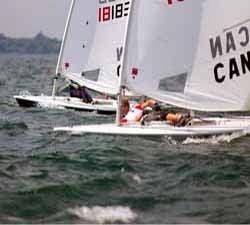Byte

By Steve Killing
I like sailing little boats. Their spirited performance lets them respond instantly to a puff or to bounce across the waves delivering quick precise feedback for the sailor. There is no sluggishness, no inertia from a heavy lead keel and no crew to buy lunch for. Small boat racing is returning to my local club in Midland, Ont., and a good part of the reason is the simplicity. Preparing the boat for a race is only a matter of minutes. The leader in this field for a long time has been the Laser, a 14-foot singlehanded daggerboard boat designed by Canadian Bruce Kirby. Manufacturing the craft has had its ups and downs but the more than 100,000 boats built are surely a milestone of success.
Two of the original driving forces behind the Laser were Ian Bruce, the builder, and his right-hand man Peter Bjorn. They have now teamed up to produce the Byte, a new singlehander for small folks. Ian Bruce heard sailors crying out of a smaller, lighter, more affordable Laser, one that would suit children or smaller adults. For young sailors learning the sport, there was no logical singlehander to race — the Laser was too much boat and sail for their 80 to 140 pounds to lift, rig and hike flat. At 12 feet overall, the Byte lies in size between the 11-foot Europe Dinghy, the new Olympic singlehander for women, and the Laser, incorporating some of the best features of both.
There is no hiding the fact that Ian Bruce was involved in the Laser — the hull shape he drew for this boat is just a mini version. For practicality, the centreboard and rudder can be interchanged with the Laser’s. The deck hardware and cockpit layout, however, have both changed for the better. The biggest change is in the sheeting arrangement for the mainsail. There is a nice, free-running traveller in the middle of the cockpit for the mid-boom mainsail sheet. This makes tacks and gybes cleaner as the sheet won’t get caught on the transom corners – a common problem with aft travellers. The cockpit is large enough to accommodate two (small) adults or perhaps a youngster and a coach. The edges of the cockpit are nicely chamfered for comfortable hiking.
The last hassle to overcome with the unstayed rig and a sleeved sail is how to hoist the sail. The usual procedure is to slide the sleeve sail onto the spar and then carry the entire sail and mast over to the boat and plunk it in the mast hole. While manageable by adults, young sailors find this manoeuvre akin to the log-toss at the Highland Games — impossible by mere mortals. So the Byte has a zippered luff. The mast is put in the boat (or left in the boat) and then the leading edge of the sail zippered around it — as the halyard is hoisted, the zipper is zipped closed, until the entire luff is wrapped around the mast.
This boat is a lot of fun for the 90 to 165 lbs crowd. And Ian Bruce feels that includes about 100 per cent of early adolescents, 90 per cent of adult females and 40 per cent of adult males. Not a bad market size. If you are one of them.
Originally published in Canadian Yachting’s October 1992 issue.
Specifications
LOA 12 ft.
Beam 4 ft. 3 in.
Sail Area 58 sq. ft.
Hull Weight 100 lbs.






















